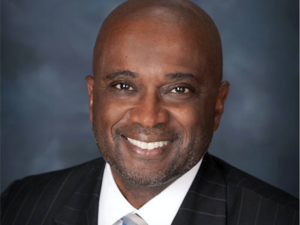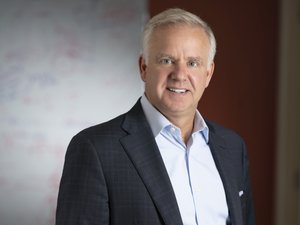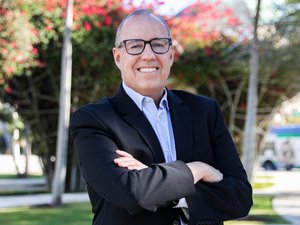On Thursday afternoon, Starship Technologies officially cut the ribbon on its new D.C. office and let loose its fleet of semi-autonomous delivery bots, which will be answering orders for food delivery app Postmates. (This isn't totally new; they've been testing out a couple block radius for a few months now.) We had a lot of questions about these new sidewalk-sharers, so DC Inno caught up with Starship Technologies Head of Operations for D.C., Nick Handrick after the ceremony.
DC Inno: Everyone's biggest question, aren’t these going to get vandalized?
Nick Handrick: Naturally, anything that's in public space, on a sidewalk, that's a thought that a lot of people have, and a question we get quite a bit. The robots are equipped with a number of anti-theft measures that double as anti-vandalism. If someone were to try to steal the robot, steal the food inside it, in terms of security, we have a number of GPS units [so it could be tracked if someone were to steal it], we have nine cameras on it, and a number of other sensors, so if someone were to mess with the robot, the robot could actually take a snapshot of their face or a video recording, so if they were to do anything illegal, then there'd be a beautiful mugshot.
In a situation where someone would try to topple it or jostle it, we also have gyroscopic sensors so the robot would realize that, and we have someone monitor in real-time. So if someone needed to jump over and see, if we have one operator overseeing a number of robots, if this robot flagged that it was being messed with, that operator could jump on, see it in real time, notify the police if need be, and we have a two way communication device so we could actually talk to that person if need be.
DC Inno: What about getting spray painted? Is that a possibility?
NH: I guess anything is a possibility. Being in the same sphere as things like bicycles, and cars, we expect the same type of approach that people are going to take to it. Eventually, that may happen once or twice. We hope that once word gets out that these things are monitoring you that that will deter a lot. But then there's also a lot of public faith. Cars get vandalized occasionally, bicycles do, but hoping we have a pretty similar success rate. It may happen once or twice but overall we think it's going to be a pretty positive experience. So far people are much more interested and happy to see them instead of upset to see them. One of the reasons we're testing in D.C. and other cities in the US is just to see how people respond to them. Thus far, we've only been here a few weeks, but it's been very positive.
[Ed note: Other safety measure discussed at the ribbon-cutting ceremony include a locking compartment during delivery to stop any would-be snack snatchers. When the Starship arrives, the compartment opens via text message for the person who ordered it.]
DC Inno: Why DC versus other cities in the United States?
NH: D.C. was actually incredibly welcoming to us. [Councilmember Mary Cheh] and the mayor's team were really happy to have us here. They're very forward-facing when it comes to technology. They were really excited to get us here. For us, D.C. is a great testing ground. The sidewalks are great but it offers some interesting dynamic in terms of delivery density – how many people are walking around, how many people live in an area. Some great boutique restaurants that we get to deliver from, and then our partner Postmates has been really helpful in bringing us to DC and getting some local restaurant partners on board so that we can actually deliver to live people, which is the name of the game.
DC Inno: How much does one cost to replace, if they were to get vandalized?
NH: We don't sell them [to the public]. That's a great question. They're fairly affordable, but obviously they're expensive devices. We recognize the fact that to have a huge number of these in cities, they have to be cost effective, so we're trying to bring that cost down to be where we could actually have a huge number of them, so that in a situation like that that would happen we could easily replace it.
DC Inno: How many starships are on the streets right now?
NH: At the moment, DC has given us permission to drive five on the sidewalks, so we've had five at a time out there running. Our fleet is actually larger, but we only ever operate five at a time.
DC Inno: If you're using five starships at a time, how many operators is that?
NH: It depends. Long term, those robots and more would be able to be handled by single operator. At the moment, in D.C. because we're so early, we're monitoring it very closely so we do have a one-to-one relationship.
DC Inno: What are your eventual goals?
NH: We see ourselves really well-suited for anything in the last mile of delivery area. Restaurant food is where we are in the US right now. We hope to expand that quite a bit with new partners. In terms of expansion, we'd like to do grocery as well, and then packages. And something that we really hope to able to bring to cities and local retailers is the options of, for smaller mom and pop-type shops, to be able to offer on-demand delivery for less than a dollar.
DC Inno: What was the legislation process like, getting these to D.C.?
NH: We have a team that is pretty active in terms of like trying to bring them to new [environments]. When we came to DC what we wanted to do first was to introduce it and just say like, "okay here's our robot," then educate them, and kind of get an idea of what it is. Once we showed the robot, people tend to be very excited about seeing it, so it was a process, obviously like anything passing legislation.
We wanted to make sure that we're given legal permission to operate it, we don't want to do something that could potentially be illegal and then ask for forgiveness later. There are other companies in the tech industry right now that are trying things like that. What we want to do is make sure we go into places that want us and are giving us permission and then do so legally, and lay regulations so that these things are controlled, like they only go so fast, that we can only operate in certain areas, things like that.
DC Inno: What technology does it have onboard?
NH: It has 9 cameras, it has 8 ultrasonic sensors. Two cameras in the back, seven in the front. The ultrasonic sensors are essentially the same technology you have in a car reverse indicator. It has a number of other sensors inside – gyroscopes, GPS, things like that. It has six wheels. That gives it a little more ability to climb curbs, or if we get stuck in a pothole or a snowbank, it can actually climb out of that.
It can carry up to 35 pounds. Realistically, it's capable of more than that but as you start to add more, it has impacts on things like battery-life, so right now 35 pounds has been our testing limit. Yes, they're battery run. They're zero-emissions, so they run on existing battery technology. It's been a big boost for us, because we are able to say that we are zero-emissions. As we come to new cities, they're always excited to hear that.
DC: How is the technology, other than size, different than a self-driving car?
NH: Our robots only go 4 mph. Our detection system is capable of doing more, but we're more focused on the nearest twenty to thirty feet, whereas an autonomous car, because its moving at 50, 60 miles per hour, has to look in a much larger area. Our sensors are set up so it creates a bubble of awareness around [the robot], so that if there's someone walking next to it, even if they're going slowly, we want to be able to respond to them. If that person stops because they're concerned with the robot, we want the robot to be able to recognize that.
DC Inno: So what cities are next?
NH: Great question. We don't have anything to announce at the moment, but just in the last three weeks the state of Virginia actually passed legislation to give us access there. We haven't announced a pilot or any testing there, but once these new states and cities give us access, we'll be really excited to expand. We want to get this in front of as many people, and because it is still a pilot and we're still testing, we want to see how people respond in different cities, in different parts of cities, and in different countries. It's really valuable for us to expand and see how it works in different areas.
DC Inno: Where are you internationally?
NH: Our company was founded in Tallinn, Estonia, so we have operations there. We also have run pilot operations in London, in Germany, and in Switzerland.
DC Inno: Why are the starships so cute and friendly-looking? [Ed. note: author's opinion, of course]
NH: I think one of the design decisions behind this was to make it something that you feel comfortable with having in your neighborhood. If I'm a parent with a young child, we want this to be something that, unlike the standard Terminator-look that people feel with some existing robotics, we wanted it to be something that is sort of endearing, something that you see and you're very comfortable with, and that you're willing to let go on its way. It catches some eyes, but we wanted it to be cute enough that you like it but we also want it to not be intrusive, something that you feel comfortable with driving around your kids or your dogs.
I grew up in the D.C. area, so just seeing them on the sidewalks here is neat. Very anecdotally, we get about 80% of people, when they see it for the first time, they either look at it or ask questions, and then after about five or ten times [start to ignore it]. The goal is that we almost want you to be able to ignore it and it just be a part of your life. And we've already seen, around the office and a couple blocks up 14th street, that people tend to see it and after a few times they might glance at it, and then they just kind of let them go.
Check out Starship's robots in action:




